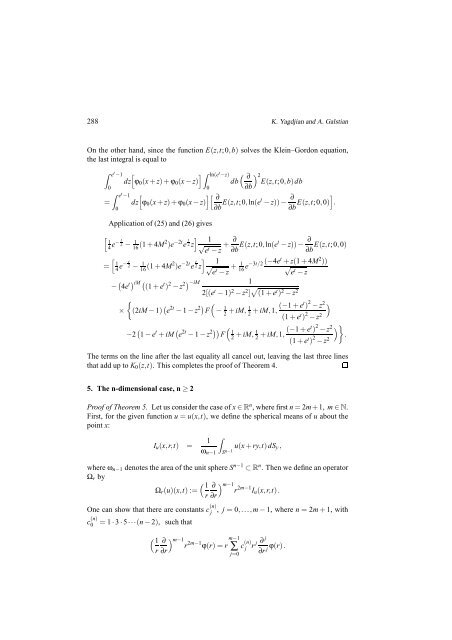The Klein-Gordon equation in anti-de Sitter spacetime - Seminario ...
The Klein-Gordon equation in anti-de Sitter spacetime - Seminario ...
The Klein-Gordon equation in anti-de Sitter spacetime - Seminario ...
You also want an ePaper? Increase the reach of your titles
YUMPU automatically turns print PDFs into web optimized ePapers that Google loves.
288 K. Yagdjian and A. GalstianOn the other hand, s<strong>in</strong>ce the function E(z,t;0,b) solves the <strong>Kle<strong>in</strong></strong>–<strong>Gordon</strong> <strong>equation</strong>,the last <strong>in</strong>tegral is equal to∫ e t −10∫ e t −1=0[dz ϕ 0 (x+z)+ϕ 0 (x−z)[dz ϕ 0 (x+z)+ϕ 0 (x−z)Application of (25) and (26) gives]∫ ln(e t −z)0( ∂) 2E(z,t;0,b)dbdb∂b∂b E(z,t;0,ln(et − z))− ∂ ]∂b E(z,t;0,0) .][ ∂[ ]14e − 2 t −116(1+4M 2 )e −2t e 2 t 1 z √e t − z + ∂∂b E(z,t;0,ln(et − z))− ∂ ∂b E(z,t;0,0)]=[14 e− 2 t − 1 16 (1+4M2 )e −2t e 2 t 1z √e t − z + 1 + z(1+4M 2 ))16 e−3t/2(−4et √e t − z− ( 4e t) iM((1+e t ) 2 − z 2) −iM 12[(e t − 1) 2 − z 2 ] √ (1+e t ) 2 − z 2{× (2iM−1) ( e 2t − 1−z 2) F(− 1 2 + iM, 1 2 + ) 2 − z 2 )iM,1,(−1+et(1+e t ) 2 − z 2−2 ( 1−e t + iM ( e 2t − 1−z 2)) (F 12+ iM, 1 2 + ) 2 − z 2 ) }iM,1,(−1+et(1+e t ) 2 .− z 2<strong>The</strong> terms on the l<strong>in</strong>e after the last equality all cancel out, leav<strong>in</strong>g the last three l<strong>in</strong>esthat add up to K 0 (z,t). This completes the proof of <strong>The</strong>orem 4.5. <strong>The</strong> n-dimensional case, n≥2Proof of <strong>The</strong>orem 5. Let us consi<strong>de</strong>r the case of x∈R n , where first n=2m+1, m∈N.First, for the given function u=u(x,t), we <strong>de</strong>f<strong>in</strong>e the spherical means of u about thepo<strong>in</strong>t x:I u (x,r,t) =∫1ω n−1S n−1 u(x+ry,t)dS y,where ω n−1 <strong>de</strong>notes the area of the unit sphere S n−1 ⊂R n . <strong>The</strong>n we <strong>de</strong>f<strong>in</strong>e an operatorΩ r by( 1 ∂) m−1rΩ r (u)(x,t) :=2m−1 I u (x,r,t).r ∂rOne can show that there are constants c (n)j , j = 0,...,m−1, where n=2m+1, withc (n)0= 1·3·5···(n−2), such that( 1r∂∂r) m−1r 2m−1 ϕ(r)=rm−1∑j=0c (n)j r j ∂ j∂r j ϕ(r).














